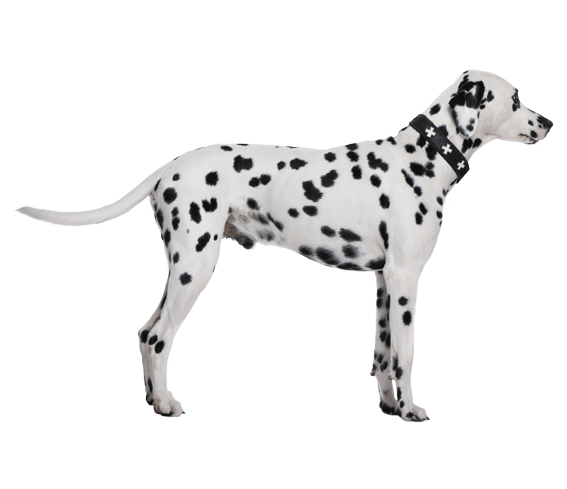Dalmatian
The Dalmatian breed is an ancient breed, its distinctive spotted coat and athletic bearing showing up in art from centuries ago. Depictions of spotted dogs consistent with the Dalmatian dog breed have been found in art from Egypt, Asia, and Europe, running alongside horses and carriages. This breed is known for their stamina, intelligence, and their loyalty, and although they are best known as coach dogs, they also make very effective ratters, hunting dogs, and if given adequate levels of exercise, loyal family companions. Their short coat is soft but tends to repel dirt, and they have very little doggy odor so frequent bathing is not required or recommended. On the other hand, frequent brushing is a must for this breed as they tend to be heavy shedders.
Dalmatian Health

- Deafness
- Urolithiasis
- Demodectic Mange
- Cataracts
- Laryngeal Paralysis
- Dalmatian Bronzing Syndrome
- Microphthalmia
- Hearing
- Blood And Urine Protein Screens
- Skin Scraping
- X-Rays
- Eye Examination
- Physical Examination
- Throat
Save on pet insurance for your Dalmatian
Now that you know what you’re in for, you may want to get ahead of future vet bills, which are typically $750-2,000 a year for a Dalmatian.
Pet Insurance can help prepare you for unexpected vet bills. Compare top providers to get a custom quote that fits your pet’s unique health needs.
Dalmatian Breed History
The history of the Dalmatian dog breed is long and shrouded in mystery. The name Dalmatian was given to the breed in 1771 by Thomas Pennant, who believed that the breed originated in the country of Dalmatia, located in the eastern Mediterranean region. Depictions of the Dalmatian breed can be found in famous art pieces from this region as far back as the 16th century, and descriptions of the dog were found in Croatian church chronicles from 1719 and 1737 under the Latin name Canis Dalmaticus. Many people feel that the origins of the breed are actually far older than that, citing illustrations found in Egyptian tombs of black and white spotted dogs following chariots. Due to their natural affinity for horses, the distinctive shape and color of the Dalmatian has been seen running beside carriages for centuries, from gypsy caravans to the coaches of well-born ladies, to horse-drawn fire engines. In fact, they are depicted this way so often that many people forget that they also excel as guard dogs, hunting dogs for both fowl and boar, vermin extermination, shepherding, and even as performers in the circus.
Dalmatian Breed Appearance
Dalmatians are athletic animals, with a slightly arched neck and deep chest which can sometimes stop just short of being barrel-chested. They typically have a symmetrical and elegant outline, with a long, nearly straight tail that usually has a little bit of an upward curve, medium length hanging ears, and compact, rounded paws. They naturally have an intelligent and inquisitive face that clearly expresses their generally dignified but friendly personality. They have either brown or blue eyes that are set moderately well apart on their well-balanced muzzle and are a breed known for occasionally having eyes of two different colors. Their glossy, white coat overshot with dark spots is recognizable throughout the world as a Dalmatian, and is occasionally accompanied by larger patches of the darker color. Although there are only two recognized colors for Dalmatians, black spotted and liver spotted, other variations may occasionally crop up, including pale yellow or orange spots known as lemon-spotted, dark gray spots referred to as blue, and tri-color Dalmatians. Dogs with these genetic abnormalities live the same full and happy lives that black and liver spotted Dalmatians, but are typically not shown or bred.

Dalmatian Temperament
Dalmatians are best known as carriage dogs and firedogs, and they are well suited to these jobs. They are people oriented, intelligent, playful, and loyal, and although they are capable of being quite dignified when the occasion calls for it, they are just as likely to play the clown at home. Dals are people oriented and tend to be fairly adept at learning new tricks, and they do well with older children, although they may be a bit too boisterous for many infants and toddlers and interactions with these age groups should be carefully supervised. Dalmatians are well known for their endurance, their speed, and their protective natures; however, these same traits may also lead to some of the more challenging aspects to owning a Dalmatian. All the energy that is required for a dog to follow a horse-drawn carriage for miles comes out as restlessness, anxiety, and destructive tendencies if the animal is not provided with the opportunity for ample exercise on a regular basis. Although they have a natural affinity for horses, if they are not properly socialized as puppies, Dalmatians can develop aggressive and territorial behaviors towards other dogs, particularly dogs of the same sex.


Similar Maintenance Breeds to Dalmatian
Similarly Sized Breeds to Dalmatian
Dalmatian Food Consumption
Dalmatian Height & Weight



Top Dalmatian Breeders
Dalmatian Owner Experiences


